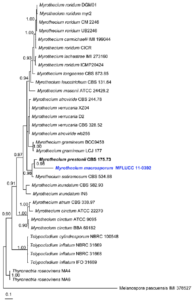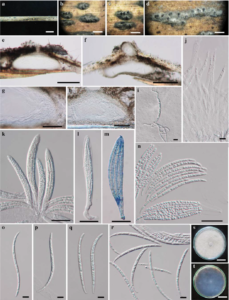Neogaeumannomyces bambusicola D.Q. Dai & K.D.Hyde.
Index Fungorum number: IF550937, Facesoffungi number: FoF00450, Fig. 2
Etymology: In reference to the host Bambusa and cola meaning loving.
Holotype: MFLU 14–0822
Saprobic on decaying bamboo culms, forming dark circular erumpent spots on host surface with ascomatal ostiolar neck with raised areas. Sexual morph Ascomata 500– 850μm diam., 350–500μm high, gregarious, solitary, immersed, globose to subglobose, black, ostiolate, soft. Ostiolar neck 50–80μm long, forming at the centre of ascomata, raised from the host surface when mature, lined with periphyses. Peridium comprising host and fungal tissues, laterally 50–70μm thick, with outer layer composed of brown and thick-walled, cells; inner layer composed of hyaline, thinwalled, large cells of textura angularis, cells 10–25×5–10μm. Hamathecium dense, with long, 5–10μm wide, septate paraphyses, intermixed with asci. Asci 105–110×10–20μm (x=107.1×12μm, n=20), 8-spored, unitunicate, cylindrical, with a short furcate pedicel, with an apical ring. Ascospores 85–105×4–5.5μm (x=99.5×4.7μm, n=20), filiform, curved to sigmoid, filiform to long fusiform, elongate, narrow and curved at the ends, 2–3-septate when mature, guttulate, hyaline, smooth-walled. Asexual morph Undetermined.
Culture characters: Ascospores germinating on PDA within 24 h with germ tubes produced from both ends. Colonies growing slowly on PDA, reaching 45 mm in 2 weeks at 28 °C, effuse, velvety to hairy, fimbriate at the margin, drift white from forward, dark brown from the reverse. Mycelium superficial and immersed branched, septate, smooth, hyaline and irregular.
Material examined: THAILAND, Chiang Rai, Doi Tung, on dead culm of bamboo (Bambusae), 4May 2011, Dong-Qin Dai DDQ 0004 (MFLU 14–0822, holotype), (isotype in KUN, under the code of HKAS), ex-type living culture, MFLUCC 11–0390. GenBank ITS: KP744449; LSU: KP744492; SSU: KP753956.
Notes: The morphology and phylogeny of taxa in the family Magnaporthaceae have been studied in detail (Walker 1972; Hirata et al. 2007; Huhndorf et al. 2008; Thongkantha et al. 2009; Wong et al. 2012; Luo and Zhang 2013; Murata et al. 2014). Our new species can be separated from other genera in Magnaporthaceae by morphology combined with the phylogenetic analysis (Fig. 1). Neogaeumannomyces is similar to Gaeumannomyces in having perithecial ascomata with long necks and cylindrical asci producing filiform ascospores (Walker 1972). However, Neogaeumannomyces differs in having a mycelial subiculum growing on the host without hyphopodia, whereas Gaeumannomyces species produce hyphopodiate mycelia (Walker 1972).

Fig. 28 Phylogram generated from Bayesian analysis based on combined alignment of ITS and LSU gene regions. Bayesian posterior probabilities (PP) greater than 0.90 are indicated above or below the nodes. The extypes (reference strains) are in bold, the new isolates are in blue. The tree is rooted with Sordaria fimicola CBS 723.96

